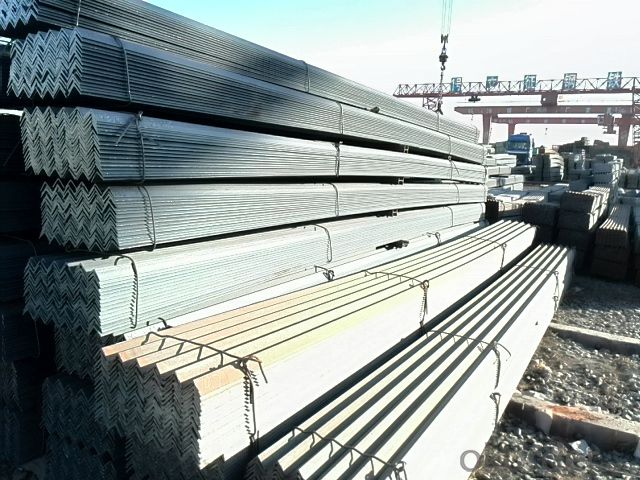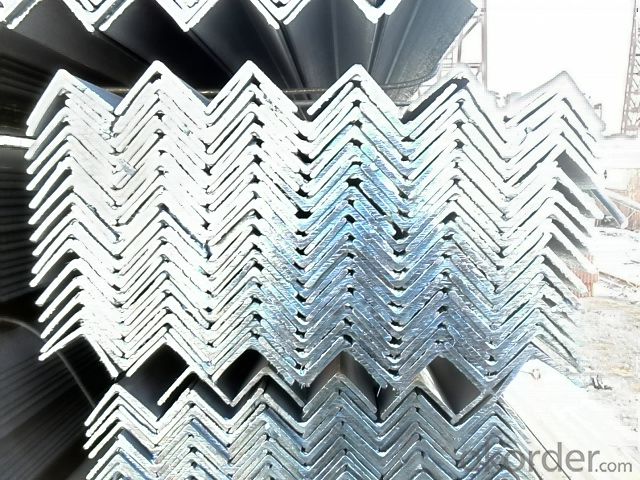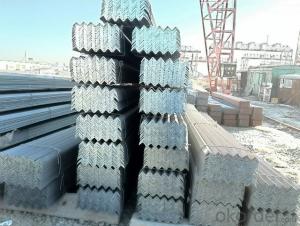Steel Angle Bars Hot Rolled Source from China
- Loading Port:
- Tianjin
- Payment Terms:
- TT OR LC
- Min Order Qty:
- 25 m.t
- Supply Capability:
- 10000 m.t/month
OKorder Service Pledge
OKorder Financial Service
You Might Also Like
Item specifice
Okorder.com is a professional materials & equipment supplier & manufacturer, offers integrated one-stop services including real-time quoting and online cargo tracking. We are funded by CNBM Group, a Fortune 500 enterprise and the largest materials & equipment firm in China.
Product Applications:
According to the needs of different structures, Angle can compose to different force support component, and also can be the connections between components. It is widely used in various building structures and engineering structures such as roof beams, bridges, transmission towers, hoisting machinery and transport machinery, ships, industrial furnaces, reaction tower, container frame and warehouse etc.
Product Advantages:
OKorder's Steel Angles are durable, strong, and resist corrosion.
Main Product Features:
· Premium quality
· Prompt delivery & seaworthy packing (30-45 days after receiving deposit)
· Corrosion resistance
· Can be recycled and reused
· Mill test certification
· Professional Service
· Competitive pricing
Product Specifications:
1. Invoicing on theoretical weight or actual weight as customer request
2. Length: 6m, 9m, 12m as following table
3. Sizes

Sizes: 25mm-250mm | ||
a*t | ||
25*2.5-4.0 | 70*6.0-9.0 | 130*9.0-15 |
30*2.5-6.6 | 75*6.0-9.0 | 140*10-14 |
36*3.0-5.0 | 80*5.0-10 | 150*10-20 |
38*2.3-6.0 | 90*7.0-10 | 160*10-16 |
40*3.0-5.0 | 100*6.0-12 | 175*12-15 |
45*4.0-6.0 | 110*8.0-10 | 180*12-18 |
50*4.0-6.0 | 120*6.0-15 | 200*14-25 |
60*4.0-8.0 | 125*8.0-14 | 250*25 |
4.Material details:
Alloy No | Grade | Element (%) | |||||
C | Mn | S | P | Si | |||
Q235 | B | 0.12—0.20 | 0.3—0.7 | ≤0.045 | ≤0.045 | ≤0.3 | |
Alloy No | Grade | Yielding strength point( Mpa) | |||||
Thickness (mm) | |||||||
≤16 | >16--40 | >40--60 | >60--100 | ||||
≥ | |||||||
Q235 | B | 235 | 225 | 215 | 205 | ||
Alloy No | Grade | Tensile strength (Mpa) | Elongation after fracture (%) | ||||
Thickness (mm) | |||||||
≤16 | >16--40 | >40--60 | >60--100 | ||||
≥ | |||||||
Q235 | B | 375--500 | 26 | 25 | 24 | 23 | |
FAQ:
Q1.What's your payment terms ?
A1:1)100% irrevocable L/C at sight.
2)30% T/T prepaid and the balance against the copy of B/L.
3)30% T/T prepaid and the balance against L/C
4)100% irrevocable L/C at 90/120/180 sight.
Q2: How do we guarantee the quality of our products?
A2: We have established an advanced quality management system which conducts strict quality tests at every step, from raw materials to the final product. At the same time, we provide extensive follow-up service assurances as required.
Q3: Can fit in the containers of 20fts for 6M long ?
A3: Yes, we can put them into the containers in the form sideling, in this way we can save the buyer much ocean freight.
Images:


- Q:What are the different types of connections used for steel angles in commercial applications?
- There are several types of connections used for steel angles in commercial applications, including bolted connections, welded connections, and cleat connections. Bolted connections involve using bolts and nuts to secure the angles together, while welded connections involve fusing the angles together using welding techniques. Cleat connections involve using a separate piece of steel, called a cleat, to connect the angles together. The choice of connection type depends on factors such as the load requirements, design specifications, and ease of installation.
- Q:Can steel angles support heavy loads?
- Yes, steel angles can support heavy loads. Steel angles, also known as L-shaped metal bars, are commonly used in construction and engineering applications due to their strength and durability. The design of steel angles allows them to distribute weight evenly, making them capable of withstanding heavy loads. They are often used as structural supports or as reinforcement in various structures such as buildings, bridges, and machinery. Additionally, the versatility of steel angles allows engineers to customize their dimensions and thickness to meet specific load requirements, making them a reliable choice for supporting heavy loads.
- Q:Can steel angles be used as supports for suspended acoustical ceilings?
- Yes, steel angles can be used as supports for suspended acoustical ceilings. Steel angles are commonly used in construction for providing structural support and stability. They can be attached to the walls or ceiling to create a framework for suspending acoustical ceiling panels. The angles provide a stable base for the ceiling system and help distribute the weight evenly, ensuring the longevity and durability of the suspended acoustical ceilings.
- Q:Can steel angles be used in transportation or infrastructure projects?
- Indeed, transportation or infrastructure projects can incorporate steel angles. Owing to their robustness and endurance, steel angles are frequently employed in construction. They are commonly utilized to furnish structural reinforcement and steadiness in a myriad of scenarios, including bridges, buildings, highways, and railways. In the realm of transportation projects, steel angles can be employed to fabricate vehicle ramps, guardrails, and frameworks for overhead signs. In infrastructure projects, they can be leveraged to erect retaining walls, foundations, and frameworks for utility installations. The adaptability and dependability of steel angles render them a favored option in these particular project types.
- Q:Can steel angles be painted over?
- Yes, steel angles can be painted over. Prior to painting, it is important to ensure that the surface is clean and free from any dirt, oil, or rust. This can be achieved by using a wire brush or sandpaper to remove any loose particles and then wiping the surface with a clean cloth. Once the surface is properly prepared, a primer specifically designed for metal surfaces should be applied to promote adhesion and prevent corrosion. After the primer has dried, a suitable paint can be applied using a brush, roller, or spray gun. It is recommended to use paints that are specifically formulated for metal applications to ensure proper adhesion and durability. Regular maintenance and repainting may be required over time to maintain the appearance and protect the steel angles from corrosion.
- Q:What are the different surface coating options for steel angles?
- There are several different surface coating options available for steel angles, depending on the specific requirements and desired properties. Some of the most common options include: 1. Galvanizing: This is a popular coating method where a layer of zinc is applied to the steel surface. Galvanizing provides excellent corrosion resistance, making it suitable for outdoor applications or environments with high moisture levels. 2. Powder coating: Powder coating involves electrostatically applying a dry powder to the steel surface, which is then cured through heat to form a durable and smooth coating. It offers a wide variety of colors and finishes while providing good corrosion resistance and aesthetics. 3. Paint: Painting is another common coating method that involves applying a layer of paint to the steel surface. Paint offers a range of colors and finishes, and it can provide corrosion protection when combined with a suitable primer. 4. Epoxy coating: Epoxy coatings are known for their exceptional corrosion resistance and chemical resistance. They are often used in environments with exposure to chemicals or harsh conditions. Epoxy coatings can be applied as a liquid or powder and are cured to form a hard and protective layer. 5. Phosphate coating: Phosphate coatings are typically used as a pre-treatment before painting or powder coating. They provide improved adhesion and corrosion resistance, acting as a base layer for subsequent coatings. 6. Anodizing: Anodizing is typically used for aluminum, but it can also be applied to steel. It involves creating a layer of oxide on the surface, which enhances corrosion resistance and provides a decorative finish. It is important to consider factors such as the intended application, environmental conditions, aesthetic preferences, and budget when selecting the appropriate surface coating option for steel angles. Consulting with coating specialists or experts can help in determining the best coating option for specific requirements.
- Q:What are the common methods of joining steel angles together?
- There are several common methods for joining steel angles together. 1. Welding: Welding is a popular method used to join steel angles together. It involves melting the edges of the angles and then allowing them to cool and solidify, creating a strong bond. Welding can be done using various techniques such as arc welding, MIG welding, or TIG welding. 2. Bolting: Bolting is another common method used to join steel angles. It involves using bolts, nuts, and washers to secure the angles together. This method allows for easy disassembly and reassembly if needed. Bolts are typically used in conjunction with gusset plates or brackets to provide additional strength and stability. 3. Riveting: Riveting is a traditional method of joining steel angles together. It involves using a rivet, which is a cylindrical metal pin, to hold the angles in place. The rivet is inserted into pre-drilled holes in the angles and then deformed on one end to create a head, securing the angles together. 4. Adhesive bonding: Adhesive bonding is a method that involves using a specialized adhesive to join steel angles together. The adhesive is applied between the angles, and then pressure is applied to ensure a strong bond. Adhesive bonding is often used in situations where a clean and aesthetically pleasing joint is desired. 5. Mechanical fasteners: Mechanical fasteners such as screws, nails, or self-tapping screws can also be used to join steel angles together. These fasteners are inserted into pre-drilled holes and provide a secure connection. However, they may not be as strong as other methods such as welding or bolting. It is important to consider the specific requirements of the application, such as the load-bearing capacity, aesthetics, and ease of disassembly, when choosing the appropriate method for joining steel angles together.
- Q:Can steel angles be used for manufacturing vehicle frames?
- Yes, steel angles can be used for manufacturing vehicle frames. Steel angles provide structural support and are commonly used in the construction of vehicle frames due to their strength, durability, and ability to withstand heavy loads.
- Q:How do steel angles perform under lateral or wind loading conditions?
- Steel angles are commonly used in construction for their ability to withstand lateral or wind loading conditions. Due to their shape and structural design, steel angles offer excellent resistance against bending and twisting forces. They distribute the applied loads efficiently, ensuring stability and minimizing any potential structural damage. Overall, steel angles are reliable and perform exceptionally well under lateral or wind loading conditions.
- Q:What are the advantages of using steel angles over other materials?
- There are several advantages of using steel angles over other materials. Firstly, steel angles are known for their superior strength and durability. Steel is a highly robust material that can withstand heavy loads and extreme weather conditions. This makes steel angles ideal for structural applications where strength and stability are crucial, such as in building construction and bridge supports. Secondly, steel angles offer excellent versatility in design and fabrication. They can be easily cut, welded, and formed into various shapes and sizes, allowing for customized solutions that meet specific project requirements. This adaptability makes steel angles suitable for a wide range of applications, including frameworks, support brackets, and reinforcements. Furthermore, steel angles have a high resistance to corrosion. Steel is inherently resistant to rusting and can be further protected through various coatings or galvanization processes. This corrosion resistance ensures the longevity and low maintenance of steel angles, making them a cost-effective choice in the long run. Additionally, steel angles offer a high degree of fire resistance. Steel does not burn or contribute to the spread of fire, which is particularly important in applications where fire safety is a concern, such as in building structures or industrial facilities. Lastly, steel angles are readily available and cost-effective. Steel is one of the most widely used materials in the construction industry and is readily available in various sizes and grades. The abundance of steel makes it a cost-effective option, especially when compared to alternative materials that may have limited availability or higher manufacturing costs. In summary, the advantages of using steel angles include their strength, versatility, corrosion resistance, fire resistance, and cost-effectiveness. These qualities make steel angles a preferred choice for many construction and structural applications.
1. Manufacturer Overview |
|
|---|---|
| Location | |
| Year Established | |
| Annual Output Value | |
| Main Markets | |
| Company Certifications | |
2. Manufacturer Certificates |
|
|---|---|
| a) Certification Name | |
| Range | |
| Reference | |
| Validity Period | |
3. Manufacturer Capability |
|
|---|---|
| a)Trade Capacity | |
| Nearest Port | |
| Export Percentage | |
| No.of Employees in Trade Department | |
| Language Spoken: | |
| b)Factory Information | |
| Factory Size: | |
| No. of Production Lines | |
| Contract Manufacturing | |
| Product Price Range | |
Send your message to us
Steel Angle Bars Hot Rolled Source from China
- Loading Port:
- Tianjin
- Payment Terms:
- TT OR LC
- Min Order Qty:
- 25 m.t
- Supply Capability:
- 10000 m.t/month
OKorder Service Pledge
OKorder Financial Service
Similar products
New products
Hot products
Related keywords



























